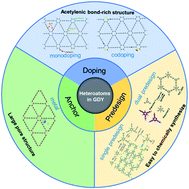Heteroatoms in graphdiyne for catalytic and energy-related applications
Abstract
The recently discovered carbon allotrope GDY possesses rich acetylenic bonds and unique pore structures, prompting GDY as an ideal candidate, tuning its electronic structure by introducing heteroatoms, broadening its usage in catalysis, energy storage and other fields. In this paper, we review different approaches to introduce heteroatoms into GDYs, including monodoping and co-doping, predesigned bottom-up synthesis of GDY, the anchoring of metal atoms into GDYs. Furthermore, we introduce the electronic properties' modification caused by these heteroatoms, including reduced diffusion barrier and adsorption energy, abundant active sites, high reversible capacity and cyclic stability, better rate performance and longer lifespan. Furthermore, the topological molecular structure of GDYs can be tuned through bottom-up synthesis methods with different monomers. GDY has great prospects for inclusion in energy storage devices such as sodium-ion batteries, lithium-ion batteries, lithium/magnesium sulfur batteries, and in electrocatalytic processes such as hydrogen evolution reactions, oxygen reduction reactions, and electrocatalytic nitrogen reduction reactions in important industrial reactions. At the end of this review, challenges and prospects of heteroatoms' introduction into GDY are discussed.

- This article is part of the themed collection: Journal of Materials Chemistry A Emerging Investigators


 Please wait while we load your content...
Please wait while we load your content...